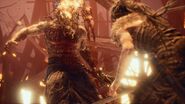| Hellblade | |
|---|---|
 | |
| Developer | Ninja Theory |
| Publisher | Ninja Theory |
| Designer(s) | Dominic Matthews |
| Writer(s) | Tameem Antoniades
Elizabeth Ashman-Rowe |
| Composer(s) | Andy LaPlegua
David García Díaz |
| Engine | Unreal Engine 4 |
| Platform(s) | PlayStation 4, PC & Xbox One |
| Release date(s) | 8th August, 2017 (PS4 & PC)
11th April, 2018 (Xbox One) |
| Genre(s) | Hack n' Slash / Action-adventure |
| Mode(s) | Single Player |
| Rating(s) | Not yet rated |
| Media | Digital Download |
| Website | hellblade.com |
Hellblade: Senua's Sacrifice is an action adventure video game developed and published by Ninja Theory for the PlayStation 4 and PC. The game was initially announced at Sony's Gamescom 2014 media briefing and is described as "independent AAA" game, a title designed to be developed and published independently but with all the quality and production values of any AAA game on the market.
The story of Hellblade is based on Celtic and Norse mythology and follows the story of a Pict warrior named Senua as she embarks on a very personal journey through a hellish underworld.
Gameplay[]
The gameplay of Hellblade is primarily focused on exploration and combat. Players explore detailed environments based on the mythology of Norse gods and realms in order to guide Senua to her eventual goal of the underworld of Helheim. The environments can contain visual based puzzles of locating Norse runes in the world in order to unlock gates and seals, which Senua can find by Focusing on them. In addition, there are numerous Lorestones that can be collected in order to learn more information about the legends of the Northmen.
Certain areas of Hellblade force Senua into combat with hellish manifestations of the Northmen. When in combat, Senua has access to both light and heavy attacks with her sword that she can use in a combo system to strike her foes down. She has the ability to dodge incoming attacks and can also guard against enemy strikes. She can even parry those strikes when timing her guard correctly and temporarily stun them, though some attacks that are blocked with incorrect timing with temporarily stun her instead.
Senua can also build up her Focus in combat by successfully blocking and striking enemies, When she has gained enough, she can temporarily slow down time to allow her foes to be dispatched with ease.
Hellblade uses an automatic saving system and only holds one save file at a time for the duration of the game. Near the beginning of the story, Senua is infected with the 'dark rot', a corruption of her flesh on her right arm that acts as a symbol of her psychosis. The more times that she is killed, the further up her arm the rot will travel. The game warns that once the rot reaches her head, the 'seat of her soul', then Senua's quest will end and all of the player's progress will be lost.
Plot[]
The story of Hellblade is based on Senua, a young Pict warrior who suffers from severe psychotic mental illness, on a journey to save the soul of her lover, Dillion, from the Norse underworld of Helheim.
Development[]
According to Ninja Theory, over the course of the last 14 years, they have developed three key strengths that define their games: ninja-class combat, strong character stories, and a unique art vision. In Hellblade, they wanted to take these three key strengths to the next level. To do this, the developers decided to focus their game's story on a unique hero's journey by using psychotic mental illness as one of the central themes of the game. Overall, Hellblade's production used 20 of Ninja Theory's staff to create.
In order to properly portray Senua's psychosis in a way that was both realistic and non-reliant on typical tropes used to portray mental illness in other forms of media, Ninja Theory consulted with world-leading neuroscientists as well as organisations such as the Welcome Trust during the development of the game. They also conducted interviews and meetings with actual sufferers of psychosis and used their experiences and feedback in the game itself.
One of the Hellblade's most realistic ways to portray the symptoms of psychosis is the use of binaural audio, a recording technique that mimics the way that humans hear things, allowing for a high level of accuracy when visualizing where a sound is coming from. The Furies, the voices that Senua hears, were recorded in binaural audio, giving the illusion that they are speaking right in the player's ear.
Though the game was initially a PlayStation only title, a PC version was revealed in 2015. The game's additional subtitle of Senua's Sacrifice was revealed just over a year later. Both versions were released in August of 2017 simultaneously.
In April of 2018 the game was also released for Xbox One.



